
The Metro-North Commuter Railroad Company, also branded as MTA Metro-North Railroad and commonly called simply Metro-North, is a suburban commuter rail service operated by the Metropolitan Transportation Authority (MTA), a public authority of the U.S. state of New York. Metro-North serves the New York Metropolitan Area, running service between New York City and its northern suburbs in New York and Connecticut, including Port Jervis, Spring Valley, Poughkeepsie, Yonkers, New Rochelle, Mount Vernon, White Plains, Southeast and Wassaic in New York and Stamford, New Canaan, Danbury, Bridgeport, Waterbury, and New Haven in Connecticut. Service in Connecticut is operated under contract with the Connecticut Department of Transportation. Similarly, service on lines west of the Hudson River is operated under contract with NJ Transit. Metro-North also provides local rail service within the New York City boroughs of Manhattan and the Bronx.

Marble Hill station is a commuter rail stop on the Metro-North Railroad's Hudson Line, serving the Marble Hill neighborhood of Manhattan in New York City. The station is located at 125 West 225th Street, two blocks west of the Broadway Bridge on the north side of the Harlem River, near the New York City Subway's Marble Hill–225th Street station.

Harlem–125th Street station is a commuter rail stop serving the Metro-North Railroad's Hudson, Harlem, and New Haven Lines. It is located at East 125th Street and Park Avenue in East Harlem, Manhattan, New York City. The station also serves as an important transfer point between the Metro-North trains and the New York City Subway's IRT Lexington Avenue Line for access to the Upper East Side of Manhattan. It is the only station besides Grand Central Terminal that serves all three lines east of the Hudson River. Trains leave for Grand Central Terminal, as well as to the Bronx and the northern suburbs, regularly.

Dover Plains station is a commuter rail stop on the Metro-North Railroad's Harlem Line, located in Dover, New York.

Harlem Valley–Wingdale station on the Metro-North Railroad's Harlem Line, located in the Wingdale section of Dover, New York. It is adjacent to the site of the former Harlem Valley State Hospital.

Pawling station is a commuter rail stop on the Metro-North Railroad's Harlem Line, located in Pawling, New York.
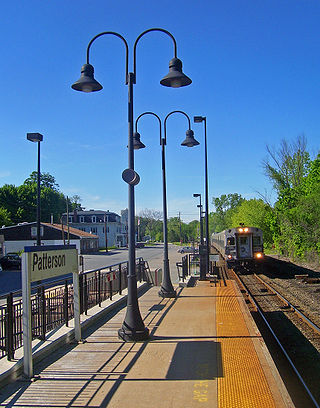
Patterson station is a commuter rail stop on the Metro-North Railroad's Harlem Line, located in Patterson, New York.

Brewster station is a commuter rail stop on the Metro-North Railroad's Harlem Line, located in Brewster, New York, United States.
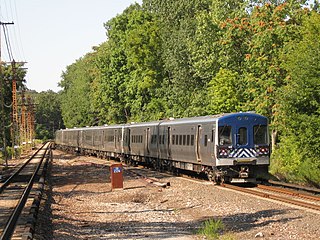
The Harlem Line is an 82-mile (132 km) commuter rail line owned and operated by the Metro-North Railroad in the U.S. state of New York. It runs north from New York City to Wassaic, in eastern Dutchess County. The lower 53 miles (85 km) from Grand Central Terminal to Southeast, in Putnam County, is electrified with a third rail and has at least two tracks. The section north of Southeast is a non-electrified single-track line served by diesel locomotives. Before the renaming of the line in 1983, it eventually became the Harlem Division of the New York Central Railroad. The diesel trains usually run as a shuttle on the northern end of the line, except for rush-hour express trains in the peak direction.
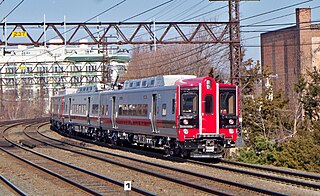
The New Haven Line is a 72.7 mi (117.0 km) commuter rail line operated by the Metro-North Railroad in the U.S. states of New York and Connecticut. Running from New Haven, Connecticut, to New York City, the New Haven Line joins the Harlem Line in Mount Vernon, New York, and continues south to Grand Central Terminal in Manhattan. The New Haven Line carries 125,000 passengers every weekday and 39 million passengers a year. The busiest intermediate station is Stamford, with 8.4 million passengers, or 21% of the line's ridership.

Purdy's station is a commuter rail stop on the Metro-North Railroad's Harlem Line, located in North Salem, New York.

Katonah station is a commuter rail stop on the Metro-North Railroad's Harlem Line, located in Katonah, New York.

Mount Kisco station is a commuter rail stop on the Metro-North Railroad's Harlem Line, located in Mount Kisco, New York, United States.

Pleasantville station is a commuter rail stop on the Metro-North Railroad's Harlem Line, located in Pleasantville, New York. There is also bus service to the station from Pace University.

Hawthorne station is a commuter rail stop on the Metro-North Railroad's Harlem Line, located in Mount Pleasant, New York.
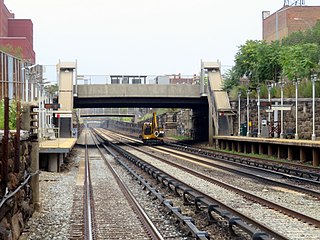
Tremont station is a commuter rail stop on the Metro-North Railroad's Harlem Line, serving the Tremont section of the Bronx, New York City. The station is in an open cut at the intersection of Park Avenue and East Tremont Avenue. Service at Tremont is limited; trains stop every 30 minutes during rush hours, every hour otherwise. The station has two high-level side platforms, each two cars long, serving the outer tracks of the four-track line.

Williams Bridge station is a commuter rail stop on the Metro-North Railroad's Harlem Line, serving the Williamsbridge and Norwood sections of the Bronx, New York City. The station is located at the intersection of Gun Hill Road and Webster Avenue. The station has two offset high-level side platforms, each four cars long, serving the outer tracks of the four-track line.

Woodlawn station is a commuter rail stop on the Metro-North Railroad's Harlem Line, serving the Woodlawn section of the Bronx, New York City. It is located on East 233rd Street near Webster Avenue. Just north of the station is Woodlawn Junction, where the New Haven Line splits from the Harlem Line to join the Northeast Corridor.
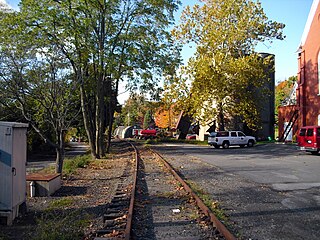
The Metro-North Railroad's Beacon Line is a non-revenue line connecting the railroad's three revenue lines east of the Hudson River. From west to east, the lines that connect are Hudson Line, Harlem Line, and the Danbury Branch of the New Haven Line. It was purchased by Metro-North in 1995 for $4.2 million from Maybrook Properties, a subsidiary of the Housatonic Railroad, to preserve it for future use, training, and equipment moves. Maybrook Properties purchased the line from Conrail after Conrail withdrew from the Danbury, Connecticut, freight market in 1992.

The Hell Gate Line is the portion of Amtrak's high-speed Northeast Corridor between Harold Interlocking in Sunnyside, Queens, and Shell Interlocking in New Rochelle, New York, within the New York metropolitan area.




















